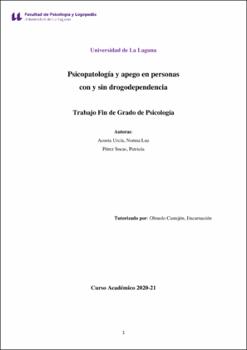Psicopatología y apego en personas con y sin drogodependencia
Date
2021Abstract
El objetivo de este estudio es establecer si existe alguna relación entre las diferentes
dimensiones en psicopatología y los estilos de apego. Se pretende observar si en la
muestra normalizada predomina un estilo de apego seguro en comparación con la
drogodependiente y que, en ésta última, existan mayor número de psicopatologías. Para
ello, se ha contado con una muestra de 115 participantes, de los cuales 69 son sujetos sin
problemas de adicción y 45 son sujetos con drogodependencia en tratamiento a los que
se le ha aplicado el cuestionario RQ (Bartholomew y Horowitz, 1991) y el SA-45
(González de Rivera y De las Cuevas, 1988). En los resultados, se obtiene que, en ambas
muestras, predomina el estilo de apego seguro, aunque se da en mayor medida en la
muestra normal; y en la drogodependiente, hay más apego inseguro, así como mayor
número de psicopatologías. También, se observó que las variables que mas correlacionan
significativamente son depresión y sensibilidad interpersonal en la muestra normalizada
y, en la drogodependiente, se dio mayor significación estadística entre sensibilidad
interpersonal y hostilidad. Las dimensiones patológicas correlacionan en menor medida
con los diferentes estilos de apego. Finalmente, no se encontraron diferencias
significativas respecto al género. The main purpose of this study is to establish whether there is any relationship between
the different dimensions of psychopathology and the styles of attachment. The key aim is
to observe whether a secure attachment style predominates in the standard sample
compared to the drug-addicted one and that, in the latter, there are a greater number of
psychopathological disorders. To do so, a sample of 115 participants was taken into
account, of which 69 were non-addicts and 45 were subjects with addiction undergoing
treatment, of whom all have taken the RQ questionnaire (Bartholomew and Horowitz,
1991) and the SA-45 questionnaire (González de Rivera and De las Cuevas, 1988). In the
results, it was found that, in both samples, the style of secure attachment predominates,
although it occurs more in the standard sample; and in the drug-addicted sample, there is
more insecure attachment, as well as a greater number of psychopathological disorders.
Furthermore, it was also observed that the variables that most significantly correlated
among themselves were depression and interpersonal sensitivity in the standard sample;
in contrast to the drug-addicted sample, in which a greater statistical significance was
found between interpersonal sensitivity and hostility. Pathological dimensions correlate
to a lesser extent with the different attachment styles. Finally, no significant differences
were found regarding gender.





